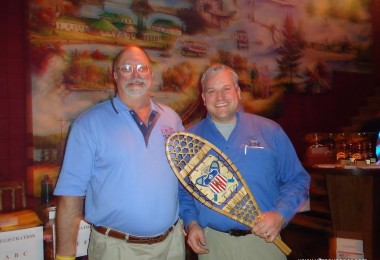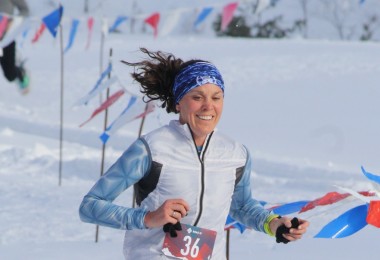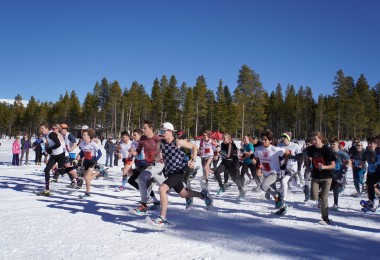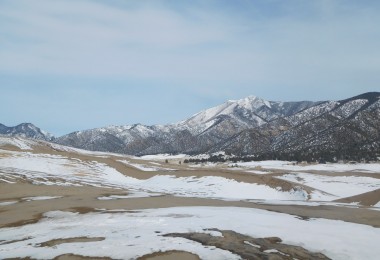Snowshoeing for many people represents that slice of “get-away” time…a moment of rest for the mind and a release of stress…a quiet hike through the backcountry; ah, snowshoeing can be so great.
However, snowshoeing can be done competitively and it’s not that difficult to get involved. If you are one of the curious spectators at a snowshoeing race or you’ve considered satisfying that need to compete, it’s time to plan for an upcoming winter of intense racing.
As Vince Lombardi once said: “It is time for us all to stand and cheer for the doer, the achiever — the one who recognizes the challenge and does something about it.”
Here’s how to do something about it and get involved:
Obviously, racing is going to require your body to be fit and ready to contend with endurance issues – start conditioning now. It’s never to late to begin that fruit and granola diet everybody has been raving about (or not). Nevertheless, failing to be prepared physically could hinder you from competing at all, let alone trying to place high in the standings. Over the next several months, especially during the summer, it would be wise to start an active lifestyle as a trail runner.
“During the summer, get off the road and get on the trails and really make that a significant component of your training,” said Mark Elmore, sports director with the United States Snowshoe Association (USSSA).
Snowshoeing competitively within any distance category will require endurance expertise; get ready for intense involvement in what will become a complete immersion in total body fitness.
Although it will become difficult to become successful at first – if it was easy, everybody would be doing it – the fruits of your labor will become apparent after trudging through preparing your body physically and mentally.
Once you have become prepared enough to compete in an event, it’s necessary to find snowshoeing competitions that meet your needs.
“If you’ve made the decision to experience and explore competitive snowshoe racing, it’s a good idea to learn as much as you can about racing: Talk with people, find out what products are popular among the racing groups, work through your local retailers, and interact with the snowshoe manufacturers’ Web sites to find information,” said Elmore.
The USSSA’s Web site holds a wealth of information on racing events throughout the nation, all organized by region via its event calendar. And, reiterating what Elmore suggested, the manufacturers have extensive event calendars that provide detailed information on races that all can enjoy – no matter the skill level. And, as Snowshoe Magazine evolves as a resource, the Web site will provide events through its calendar area as well.
“At that point, it’s a matter of getting out on the snow, finding out what works best for you in terms of what clothing you wear and the diet (whether you eat before and after a race depending on the distance) – all those things that most runners are somewhat aware of, their racing protocols and habits,” said Elmore. “Get out there and give it a go. Be realistic and conservative with your first few efforts, don’t expect to jump right in and win races and bring home medals and trophies. As with any athletic competition, there is a learning process; but, have fun with it and keep at it.”
Races appear in all forms, shapes, sizes and locations. The idea is to start small. Research your region’s snowshoeing awareness, discover your state’s involvement in the industry, search for a snowshoeing club in your area and search for something that is within your limits. If you live in an area that is a great distance away from a major race, it may be worth your while to either spend some cash to travel or organize your own event (at that point, get in touch with the USSSA).
“The Beaver Creek Snowshoe Adventure Series is a huge racing event. It pulls in a lot of the top athletes in the Rocky Mountain area, but it also provides an opportunity for a lot of folks to try the sport,” said Elmore. “Another is the Midwestern Snowshoe Series – that’s pretty significant and been around for a long, long time. In the northeast, there’s the Western Massachusetts Athletic Club that puts on a series of snowshoe races that average 80 to 100 participants per event. Along with the National Championships Regional Event Series (organized by the USSSA), those are probably the larger snowshoe events in the United States. And, The Yeti snowshoes series in Canada is growing as well.”
Getting involved and increasing awareness of the sport of snowshoeing is key to its further success among those that have yet to try it. Organized events for shoers of all levels are essential to the growth of the sport.
In fact, becoming a competitive snowshoer could be the start of an illustrious career representing the United States throughout international races and contests. What many might not know is that snowshoeing has yet to be recognized as an Olympic event. Getting involved now could mean your cornerstone involvement in helping make that a reality.
“We’re hoping by 2010, perhaps we can get a snowshoe event as an Olympic winter program as an exhibition or perhaps as a demonstration, if the growth of the sport continues on an international level,” said Elmore. “That’s six years away, but we’re already looking that far down the road. We’ll keep our fingers crossed.”
However, the dream of being a snowshoeing Olympic athlete must follow the USSSA’s acceptance of you as a member of the national team. Of course the dream is the goal…the reality is the work.
“The national team is determined by how athletes place at the national championships. The top three junior girls and junior boys are on spots on the national junior team,” Elmore explained. “The top five men in the 10K and the top five women in the 10K overall earn berths on the national snowshoe team. Those athletes are eligible to represent the United States when we travel to international events. It’s the cream of the crop, the best of the best that basically attended the National Championships and performed well there.”
In the future, Snowshoe Magazine will offer competitors in the sport some great sponsorship opportunities and several avenues to pursue getting involved. Keep an eye out for some of our great initiatives to help grow the sport and the industry.
And, if you are pursuing the sport competitively…we bid you the best of luck. See you at the races!
“A non-doer is very often a critic – that is, someone who sits back and watches doers, and then waxes philosophically about how the doers are doing. It’s easy to be a critic, but being a doer requires effort, risk, and change.” — Dr. Wayne W. Dyer





